Circumflex artery 12 - Study guides, Class notes & Summaries
Looking for the best study guides, study notes and summaries about Circumflex artery 12? On this page you'll find 407 study documents about Circumflex artery 12.
Page 3 out of 407 results
Sort by
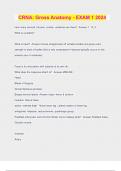
-
CRNA: Gross Anatomy - EXAM 1 2024
- Exam (elaborations) • 11 pages • 2024
-
- $12.49
- + learn more
CRNA: Gross Anatomy - EXAM 1 2024 How many cervical, thoracic, lumbar, vertebrae are there? -Answer-7, 12, 5 What is a pedicle? What is facet? -Answer-Comes straight back off vertebra bodies and gives extra strength to back of bodies (this is why compression fractures typically occurs on the anterior part of vertebrae) Facet is for articulation with tubercle of its own rib What does the trapezius attach to? -Answer-MIDLINE Head Blade of Scapula Dorsal Spineous process Biceps femoris l...
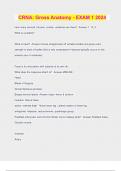
-
CRNA: Gross Anatomy - EXAM 1 2024
- Exam (elaborations) • 11 pages • 2024
- Available in package deal
-
- $12.49
- + learn more
CRNA: Gross Anatomy - EXAM 1 2024 How many cervical, thoracic, lumbar, vertebrae are there? -Answer-7, 12, 5 What is a pedicle? What is facet? -Answer-Comes straight back off vertebra bodies and gives extra strength to back of bodies (this is why compression fractures typically occurs on the anterior part of vertebrae) Facet is for articulation with tubercle of its own rib What does the trapezius attach to? -Answer-MIDLINE Head Blade of Scapula Dorsal Spineous process Biceps femoris l...
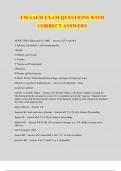
-
EM SAEM EXAM QUESTIONS WITH CORRECT ANSWERS
- Exam (elaborations) • 6 pages • 2024
-
- $11.49
- + learn more
EM SAEM EXAM QUESTIONS WITH CORRECT ANSWERS AEIOU TIPS (differential for AMS) - Answer ️️ -A Alcohol E Epilepsy, Electrolytes, and Encephalopathy I Insulin O Opiates and Oxygen U Uremia T Trauma and Temperature I Infection P Poisons and Psychogenic S Shock, Stroke, Subarachnoid Hemorrhage and Space-Occupying Lesion Delirium vs psychosis hallucinations - Answer ️️ -delerium= visual psychosis=auditory systolic vs dystolic failure - Answer ️️ -Systolic failure is the hearts...
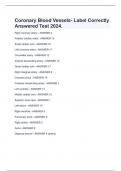
-
Coronary Blood Vessels- Label Correctly Answered Test 2024.
- Exam (elaborations) • 1 pages • 2024
-
Available in package deal
-
- $9.49
- + learn more
Coronary Blood Vessels- Label Correctly Answered Test 2024. Right coronary artery - ANSWER 4 Anterior cardiac veins - ANSWER 15 Small cardiac vein - ANSWER 16 Left coronary artery - ANSWER 11 Circumflex artery - ANSWER 12 Anterior descending artery - ANSWER 14 Great cardiac vein - ANSWER 17 Right marginal artery - ANSWER 6 Coronary sinus - ANSWER 18 Posterior descending artery - ANSWER 7
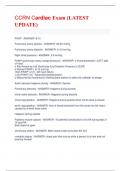
-
CCRN Cardiac Exam (LATEST UPDATE)
- Exam (elaborations) • 12 pages • 2024
-
Available in package deal
-
- $10.49
- + learn more
CCRN Cardiac Exam (LATEST UPDATE) PAOP - ANSWER- 8-12 Pulmonary artery systolic - ANSWER- 20-30 mmHg Pulmonary artery diastolic - ANSWER- 5-15 mm Hg Right atrial pressure - ANSWER- 2-6 mmHg PAWP (pulmonary artery wedge pressure) - ANSWER- o Volume/preload in LEFT side of heart. o Also known as Left Ventricular End Diastolic Pressure (LVEDP) o Normal PAWP = 6-12 mm Hg High PAWP (>12) - left heart failure Low PAWP (<6) - hypovolemia/dehydration o Measured by momentari...
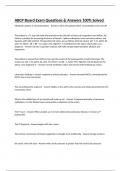
-
ABCP Board Exam Questions & Answers 100% Solved
- Exam (elaborations) • 194 pages • 2024
-
- $20.99
- + learn more
Metabolic acidosis is characterized by: - Answer a fall in the plasma HCO3- concentration and a low pH The patient is a 71 year old male who presents to the OR with a history of congestive heart failure. His history is positive for increasing shortness of breath, 3 pillow orthopnea, lower extremity edema, and dyspnea with mild exertion. Preoperative lab values are as follows (Arterial values): pH: 7.41, pCO2: 60, pO2: 50, HCO3-: 38.1, BE + 12, SaO2: 72%, Hgb/Hct: 7.6/23 Based on the above inf...
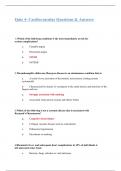
-
Quiz 4- Cardiovascular Questions & Answers
- Exam (elaborations) • 20 pages • 2023
-
Available in package deal
-
- $14.99
- + learn more
Quiz 4- Cardiovascular Questions & Answers 1. Which of the following conditions is the most immediately at risk for serious complications? a. Unstable angina b. Prinzmetal angina c. STEMI d. NSTEMI 2. Thromboangiitis obliterans (Buergers disease) is an autoimmune condition that is: a. A result of over activation of the intrinsic and extrinsic clotting system systemically b. Characterized by attacks of vasospasm in the small arteries and arterioles of the fingers and...

-
Test Bank For ECGs Made Easy 6th Edition by Barbara Aehlert Complete ALL Chapter 1-10 (2023-2024)
- Exam (elaborations) • 138 pages • 2023
-
- $28.49
- + learn more
The apex of the heart is formed by the . a. tip of the left ventricle b. tip of the right atrium c. right atrium and right ventricle d. left atrium and left ventricle ANS: A The heart’s apex, or lower portion, is formed by the tip of the left ventricle. The apex lies just above the diaphragm, between the fifth and sixth ribs, in the midclavicular line. OBJ: Identify the surfaces of the heart. 2. The left atrium receives blood from the . a. pulmonary veins b. aorta c. pulmonary arte...
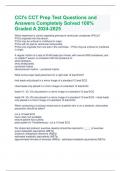
-
CCI's CCT Prep Test Questions and Answers Completely Solved 100% Graded A 2024-2025
- Exam (elaborations) • 19 pages • 2024
- Available in package deal
-
- $12.99
- + learn more
Which statement is correct regarding premature ventricular complexes (PVCs)? PVCs originate from the atrium. PVCs may be unifocal or multifocal in origin. PVCs will not lead to ventricular tachycardia. PVCs only originate from one site in the ventricles. - PVCs may be unifocal or multifocal in origin. A regular rhythm at a rate of 40-60 beats per minute, with narrow QRS complexes, and no visible P waves, is consistent with the presence of: atrial fibrillation. sinus bradycardia. juncti...
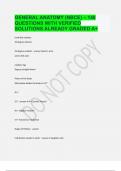
-
GENERAL ANATOMY (NBCE) – 148 QUESTIONS WITH VERIFIED SOLUTIONS ALREADY GRADED A+.
- Exam (elaborations) • 29 pages • 2023
- Available in package deal
-
- $14.99
- + learn more
Limb Bud rotation: 90 degrees lateral= 90 degrees medial= lateral= arms (arms stick out) medial= legs (legs go straight down) Planes of the body: What plane divides the body in A-P? R-L? S-I? A-P= Coronal/ Frontal R-L= Sagittal/ median S-I= Transverse/ horizontal Brainpower Read More Previous Play Next Rewind 10 seconds Move forward 10 seconds Unmute 0:00 / 0:15 Full screen Stages of Mitosis: Cell division results in what? 2 daughter ce...

That summary you just bought made someone very happy. Also get paid weekly? Sell your study resources on Stuvia! Discover all about earning on Stuvia


